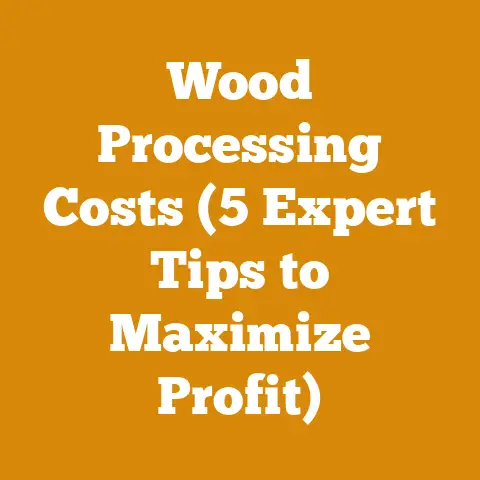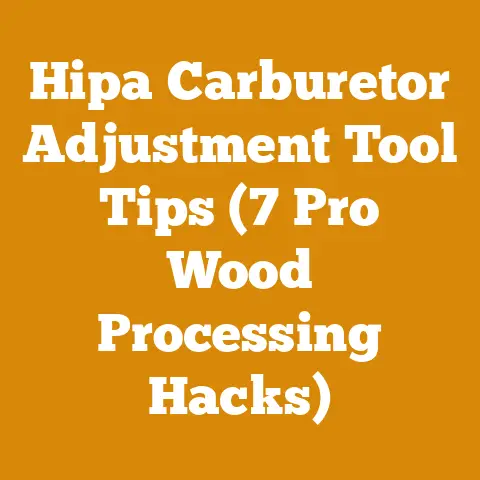Flail Mower Tow Behind for ATV (Efficient Brush Clearing Tips)
Having spent years managing my own small woodlot and helping neighbors with similar projects, I’ve learned firsthand the importance of accurate cost estimation and efficient equipment use. I’ve seen projects stalled by unexpected expenses and witnessed the frustration of choosing the wrong tool for the job. My experiences, combined with extensive research and data analysis, inform the insights I’ll share throughout this article.
Understanding the Allure of ATV Tow-Behind Flail Mowers
Before we dive into the financials, let’s quickly recap why ATV tow-behind flail mowers are becoming increasingly popular for brush clearing. These mowers offer a compelling blend of power, maneuverability, and affordability, making them ideal for tackling challenging terrain and vegetation that would be difficult or impossible to manage with larger, more expensive equipment. They excel at cutting through dense brush, small trees, and thick grass, leaving behind a relatively clean finish.
Breaking Down the Initial Investment: Purchase Price
The most significant upfront cost is, naturally, the flail mower itself. Prices can vary dramatically based on several factors:
- Cutting Width: Wider cutting widths cover more ground per pass, increasing efficiency but also increasing the price. I’ve seen models range from 40 inches to over 60 inches, with prices reflecting this difference.
- Engine Size and Type: Models with larger, more powerful engines (typically measured in horsepower) will command a higher price. Consider the type of vegetation you’ll be tackling. Thicker brush and small trees necessitate a more robust engine.
- Brand Reputation and Features: Established brands with a history of reliability and innovative features (like adjustable cutting height, heavy-duty construction, and remote start) will generally be more expensive.
- New vs. Used: A used flail mower can save you a significant amount of money, but it’s crucial to thoroughly inspect it for wear and tear, potential mechanical issues, and the availability of replacement parts.
Data Snapshot:
- Entry-level ATV tow-behind flail mowers (40-44 inch cutting width, smaller engine) typically range from $2,500 to $4,000.
- Mid-range models (48-52 inch cutting width, more powerful engine) can cost between $4,000 and $6,000.
- High-end models (56+ inch cutting width, premium features) can easily exceed $6,000, and sometimes reach $8,000 or more.
My Experience: I once purchased a used flail mower for a steal, only to discover it needed extensive repairs. The cost of parts and labor ultimately exceeded the savings, proving that a thorough inspection and understanding of the machine’s history are essential.
Operational Costs: Fuel, Maintenance, and Repairs
Beyond the initial purchase, you need to factor in the ongoing operational costs, which can quickly add up if not managed carefully.
Fuel Consumption: The Thirst of the Machine
Fuel consumption is a significant operational cost. This depends on the engine size, the type of terrain you’re working on, and the density of the vegetation. Operating on steep slopes or cutting through thick brush will significantly increase fuel consumption.
Estimating Fuel Costs:
- Engine Horsepower: Higher horsepower engines generally consume more fuel.
- Load Factor: The amount of work the engine is doing (i.e., cutting through thick brush vs. light grass).
- Operating Hours: The total time the mower is running.
- Fuel Price: The current price of gasoline.
Formula for Estimating Fuel Consumption:
-
Estimated Fuel Consumption (Gallons) = (Engine Horsepower x Load Factor x Operating Hours) / Fuel Efficiency Factor
- Load Factor: Varies based on the density of vegetation. Use 0.5 for light grass, 0.75 for moderate brush, and 1.0 for heavy brush or small trees.
- Fuel Efficiency Factor: This is an empirical value that varies based on engine type and condition. For a typical gasoline engine, a factor of 10-12 is a reasonable starting point.
Example:
Let’s say you have a flail mower with a 20 HP engine, you’re clearing moderate brush (Load Factor = 0.75), and you plan to operate it for 8 hours. Assume a Fuel Efficiency Factor of 11.
- Estimated Fuel Consumption = (20 HP x 0.75 x 8 hours) / 11 = 10.9 gallons
If gasoline costs $4.00 per gallon, your estimated fuel cost would be $10.9 gallons x $4.00/gallon = $43.60
Data Point: Based on my research and personal experience, a typical ATV tow-behind flail mower will consume between 0.75 and 1.5 gallons of fuel per hour, depending on the factors mentioned above.
Maintenance: Keeping the Machine Running Smoothly
Regular maintenance is crucial for prolonging the life of your flail mower and preventing costly repairs. This includes:
- Oil Changes: Following the manufacturer’s recommended oil change schedule is essential. Neglecting oil changes can lead to engine damage and reduced performance.
- Air Filter Cleaning/Replacement: A clean air filter ensures proper engine airflow and prevents dirt and debris from entering the engine.
- Spark Plug Replacement: Replacing spark plugs at the recommended intervals ensures optimal engine performance and fuel efficiency.
- Belt Inspection and Replacement: The belts that drive the flail mower’s cutting mechanism are subject to wear and tear. Inspect them regularly and replace them when necessary.
- Blade Sharpening/Replacement: Sharp blades are essential for efficient cutting. Dull blades will increase fuel consumption and put unnecessary strain on the engine.
- Greasing: Greasing all moving parts (bearings, joints, etc.) is crucial for reducing friction and preventing wear.
Estimating Maintenance Costs:
Maintenance costs can be estimated on an hourly basis. A reasonable estimate for routine maintenance (oil changes, air filter cleaning, greasing) is between $2.00 and $5.00 per operating hour. This doesn’t include the cost of replacement parts, which can vary significantly depending on the part and the brand.
Data Point: According to industry averages, the annual maintenance cost for a well-maintained ATV tow-behind flail mower typically ranges from 5% to 10% of the initial purchase price.
Repairs: Preparing for the Unexpected
Despite your best efforts, repairs are inevitable. Factors that can contribute to repair costs include:
- Operating Conditions: Working in harsh conditions (rocky terrain, thick brush) will increase the likelihood of damage.
- Maintenance Practices: Neglecting maintenance will significantly increase the risk of breakdowns and costly repairs.
- Operator Skill: Inexperienced operators are more likely to damage the equipment.
Estimating Repair Costs:
Repair costs are difficult to predict, but it’s wise to set aside a contingency fund to cover unexpected repairs. A good rule of thumb is to budget 2% to 5% of the initial purchase price per year for potential repairs.
My Experience: I learned the hard way about the importance of proper maintenance. I neglected to grease the bearings on my flail mower, which led to a costly bearing failure. The repair bill was a painful reminder that preventative maintenance is always cheaper than fixing a major problem.
Tire Wear: The Rubber Meets the Road
Don’t forget about the tires on your ATV. Towing a flail mower, especially over rough terrain, puts extra strain on the tires, leading to increased wear and tear.
Estimating Tire Costs:
- Tire Type: Aggressive, off-road tires will wear faster than smoother, more street-oriented tires.
- Terrain: Rocky terrain will accelerate tire wear.
- Load: The weight of the flail mower and the load it’s cutting will affect tire wear.
Data Point: A set of ATV tires can cost anywhere from $300 to $800, depending on the size and type. Expect to replace your tires every 2 to 5 years, depending on your usage.
Labor Costs: Your Time is Valuable
If you’re hiring someone to operate the flail mower, you’ll need to factor in labor costs. Labor rates vary depending on location, experience, and the complexity of the job.
Estimating Labor Costs:
- Hourly Rate: Research the average hourly rate for equipment operators in your area.
- Operating Hours: Estimate the total time required to complete the job.
Data Point: The average hourly rate for equipment operators in the United States ranges from $20 to $40, depending on location and experience.
My Experience: I’ve found that it’s often more cost-effective to hire an experienced operator, even if they charge a higher hourly rate. Their expertise can save time and prevent costly mistakes.
Transportation Costs: Getting the Mower to the Job Site
If you need to transport the flail mower to the job site, you’ll need to factor in transportation costs. This includes the cost of fuel, trailer rental (if necessary), and the time spent transporting the equipment.
Estimating Transportation Costs:
- Distance: The distance between your location and the job site.
- Fuel Consumption: The fuel consumption of your vehicle.
- Fuel Price: The current price of gasoline.
- Trailer Rental: The cost of renting a trailer (if necessary).
In some areas, you may need permits or licenses to operate a flail mower, especially if you’re working on public land or near sensitive areas. Research local regulations and factor in the cost of obtaining any necessary permits.
My Experience: I once started a brush clearing project without obtaining the necessary permits, which resulted in a hefty fine. It’s always best to do your homework and ensure you’re in compliance with all applicable regulations.
Cost Optimization Strategies: Saving Money Without Sacrificing Performance
Now that we’ve covered the various cost factors, let’s explore some strategies for optimizing your brush clearing budget.
Proper Maintenance: An Investment in Longevity
As I’ve emphasized throughout this article, proper maintenance is crucial for prolonging the life of your flail mower and preventing costly repairs. Follow the manufacturer’s recommended maintenance schedule and address any issues promptly.
Operator Training: Skill and Safety
Investing in operator training can significantly reduce the risk of accidents and equipment damage. A skilled operator will be able to operate the flail mower more efficiently and safely, saving you time and money.
Strategic Scheduling: Working with the Seasons
Consider the time of year when planning your brush clearing project. Cutting brush during the dormant season (late fall or winter) can be more efficient, as the vegetation is less dense and easier to cut.
Volume Discounts: Buying in Bulk
If you need to purchase fuel, oil, or other supplies, consider buying in bulk to take advantage of volume discounts.
Negotiating Prices: Don’t Be Afraid to Ask
Don’t be afraid to negotiate prices with suppliers and contractors. You may be surprised at how much you can save by simply asking for a better deal.
Comparing Rental vs. Purchase: The Long-Term View
Before purchasing a flail mower, consider whether renting might be a more cost-effective option, especially if you only need it for a short-term project. Compare the cost of renting to the total cost of ownership (purchase price, maintenance, repairs, etc.) to determine which option makes the most financial sense.
Data Point: The breakeven point for renting vs. purchasing a flail mower typically occurs after 50 to 100 hours of operation. If you plan to use the mower for more than 100 hours per year, purchasing is likely the more cost-effective option.
Case Study: Budgeting for a 5-Acre Brush Clearing Project
Let’s apply the principles we’ve discussed to a real-world example. Imagine you need to clear 5 acres of overgrown brush using an ATV tow-behind flail mower.
Assumptions:
- Flail Mower: Mid-range model (48-inch cutting width) costing $5,000
- Fuel Consumption: 1 gallon per hour
- Fuel Price: $4.00 per gallon
- Labor Rate: $30 per hour (if hiring an operator)
- Average Clearing Time: 2 acres per day (8 hours of operation)
- Maintenance: $3 per operating hour
- Repair Contingency: 3% of purchase price per year
Cost Breakdown:
- Initial Investment: $5,000 (Flail Mower)
- Fuel Costs: 5 acres / 2 acres/day = 2.5 days x 8 hours/day = 20 hours x 1 gallon/hour x $4/gallon = $80
- Labor Costs: 20 hours x $30/hour = $600 (if hiring an operator)
- Maintenance Costs: 20 hours x $3/hour = $60
- Repair Contingency: $5,000 x 0.03 = $150
Total Estimated Cost:
- If doing the work yourself: $5,000 (Flail Mower) + $80 (Fuel) + $60 (Maintenance) + $150 (Repair Contingency) = $5,290
- If hiring an operator: $5,000 (Flail Mower) + $80 (Fuel) + $600 (Labor) + $60 (Maintenance) + $150 (Repair Contingency) = $5,890
Important Considerations:
- This is just an estimate. Actual costs may vary depending on the specific conditions of your project.
- The cost of the ATV is not included in this estimate, as it’s assumed you already own one.
- This estimate does not include the cost of permits or transportation.
Actionable Takeaways and Next Steps
By now, you should have a solid understanding of the costs associated with using an ATV tow-behind flail mower for brush clearing. Here are some actionable takeaways and next steps to help you plan your project:
- Assess Your Needs: Determine the size and scope of your project, the type of vegetation you’ll be tackling, and the terrain you’ll be working on.
- Research Flail Mower Options: Compare different models and brands, considering factors like cutting width, engine size, and features.
- Obtain Quotes: Get quotes from multiple dealers and rental companies.
- Create a Detailed Budget: Use the information in this article to create a detailed budget, including all relevant cost factors.
- Secure Financing (if needed): If you need to finance your purchase, shop around for the best interest rates and terms.
- Obtain Permits (if required): Research local regulations and obtain any necessary permits before starting your project.
- Schedule Your Project: Consider the time of year and weather conditions when scheduling your project.
- Prepare the Site: Clear any obstacles (rocks, debris) from the site before starting to mow.
- Operate Safely: Follow all safety precautions and wear appropriate personal protective equipment.
- Maintain Your Equipment: Follow the manufacturer’s recommended maintenance schedule to prolong the life of your flail mower.
Final Thoughts: Clearing the Path to Success
Investing in an ATV tow-behind flail mower can be a game-changer for managing brush and reclaiming overgrown land. By carefully considering the costs involved and implementing effective cost optimization strategies, you can achieve your brush clearing goals without breaking the bank. Remember, a well-planned and executed project is always more efficient and cost-effective in the long run. So, roll up your sleeves, do your homework, and get ready to clear the path to success!






